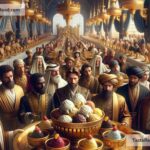The Mythical Tale of the Spice Trade: A Journey Through History
Long ago, there was a time when tiny seeds, dried leaves, and powdered roots were worth their weight in gold. These fragrant treasures, known as spices, were more than just ingredients for cooking—they were symbols of power, wealth, and mystery. The spice trade is one of the most fascinating stories from history, full of adventure, danger, and mythical allure. Let’s take a journey through the tale of the spice trade and discover how it shaped the world as we know it.
A World Obsessed with Fragrance
Imagine living in a time where perfumes filled the air, exotic flavors tickled your tongue, and spices were thought to have magical powers. Thousands of years ago, spices like cinnamon, pepper, saffron, turmeric, and cloves were believed to cure diseases, preserve food, and even protect people from evil spirits. Ancient texts and myths tell us that spices were seen as gifts from the gods, precious treasures that connected humankind to something divine.
But there was one challenge: spices did not grow everywhere. Most of them came from distant, mysterious lands that were difficult to reach. For example, cinnamon was native to Sri Lanka and southern India, cloves came from the remote Spice Islands (modern-day Indonesia), and pepper thrived in the jungles of southern Asia. People living in Europe, Africa, and the Middle East craved these treasures, but getting them was no easy task.
Spices and Ancient Trade Routes
The story of the spice trade begins thousands of years ago when people used ships, caravans, and camels to move goods across vast distances. Some of the world’s most famous trade routes came to life because of spices. The Silk Road, which connected China to Europe, carried more than just silk—spices were one of its most sought-after goods. The Incense Route in the Middle East and the Spice Routes of the Indian Ocean brought spices to different parts of the world, creating connections between cultures and nations.
These routes weren’t just practical highways; they were mysterious pathways full of danger. Merchants and sailors faced harsh weather, deadly pirates, and treacherous terrain. They kept the sources of spices a closely guarded secret, adding to their mythical reputation.
The Magic of the Spice Islands
One of the most enchanting parts of the spice trade tale is the story of the Spice Islands. These tiny islands (the Maluku Islands in modern-day Indonesia) were the world’s primary source of nutmeg, mace, and cloves. For centuries, no one knew exactly where these spices came from. Merchants spread wild stories, saying the spices were grown in lands guarded by dragons or only reachable by crossing dangerous seas.
European traders were desperate to find these mythical islands, believing they would unlock unimaginable riches. The search for the Spice Islands became one of history’s greatest adventures, leading to voyages that opened up the world. In 1498, Portuguese explorer Vasco da Gama sailed around the southern tip of Africa. His journey marked the beginning of European dominance in the spice trade.
A Battle for Spice Dominance
The arrival of Europeans in Asia changed the spice trade forever. Portugal, Spain, the Netherlands, and England sent fleets of ships to compete for control of the Spice Routes. These nations built trading posts, formed alliances, and even waged wars to monopolize the spice trade. Spices drove imperial ambitions, leading to colonization and exploitation of the lands where spices were grown.
One of the most dramatic conflicts was between the Portuguese and the Dutch in the 16th century. The Netherlands eventually took control of the Spice Islands, establishing the Dutch East India Company, one of the most powerful trading companies in history. It wasn’t just about business anymore; the spice trade was about conquering and controlling.
Spices Change the World
The mythical tale of the spice trade is not just about adventure—it’s also about how spices transformed the world. Spices helped connect continents and people. Cultures shared ideas, art, language, and knowledge through trade routes. The demand for spices led to the Age of Exploration, with explorers sailing across oceans and discovering new lands.
Spices also changed the way people cooked and ate. Imagine a world without pepper on your food or cinnamon in your coffee. The spices introduced through trade became staples in kitchens around the globe, creating flavors that we love today. Beyond the kitchen, spices influenced medicine and even politics.
The Spice Trade’s Legacy
Today, spices are easy to find. You can walk into a grocery store and pick up cinnamon or pepper without a second thought. But behind those humble jars lies one of the greatest tales in history. The mythical spice trade was a journey of curiosity and ambition, of cultures colliding and empires rising.
This ancient trade reminds us how something small—like a seed or a leaf—can change the world. The next time you sprinkle cinnamon on your dessert or grind pepper onto your meal, take a moment to think about the myths, adventures, and lives that brought these spices into your hands. The spice trade’s enchanting story will forever remain a flavorful chapter in the history of humanity.


